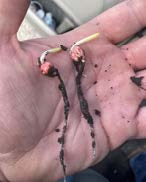By Louis Sutton
AgVenture Regional Product Manager & Agronomy Lead

Effects of confused corn.
What is Confused Corn Syndrome? Otherwise known as imbibitional chilling, it occurs when a corn seedling does not have a controlled soil temperature to grow in.
Corn emerges at 50° to 52° F as the Coleoptile positions itself in the warmest soil and then the Mesocotyl pushes to the surface under good conditions. When the soil changes temperature due to rain or colder weather, the result is that the Coleoptile will change directions and cause the plant to grow again to the warmer soil. The seedling could grow parallel with the ground surface or grow even deeper into the soil. Once the Mesocotyl starts, it keeps growing until it is told to stop, which is when the plant reaches the surface.

Corn seedling grows parallel with the ground.
I have seen corn grow parallel with the surface, in a corkscrew shape, and in circles. In all these situations, leafing out occurs underground and at the plant death. Sometimes it is blamed on the germ of the seed or abnormal seed. However, when you investigate, the weather pattern will show you the real reason. Early planting, cold rainfall, cold nights, and cool days all influence how the seedling will grow.
So, what are the best conditions to plant corn? When 10 o’clock a.m. soil temperatures reach 52°F at a three-inch depth and good weather is forecast for the next few days, you have optimal conditions. I have seen when corn is planted really early, it emerges, and growth pauses as the seedling is under stress or confused about where to grow. In contrast, corn planted later in optimal conditions will catch up and pass the early planted corn, growing healthier as it did not experience the stress of the cold soils.
Only you can control the planting time and correct planting protocols; sound management of your corn depends on planting in proper conditions.
Coming soon to the AgVenture Seeds for Success blog: Can you tell the difference between a Wireworm and a False Wireworm? Are you setting yourself up for Lazy or Floppy corn? Come back to learn more!